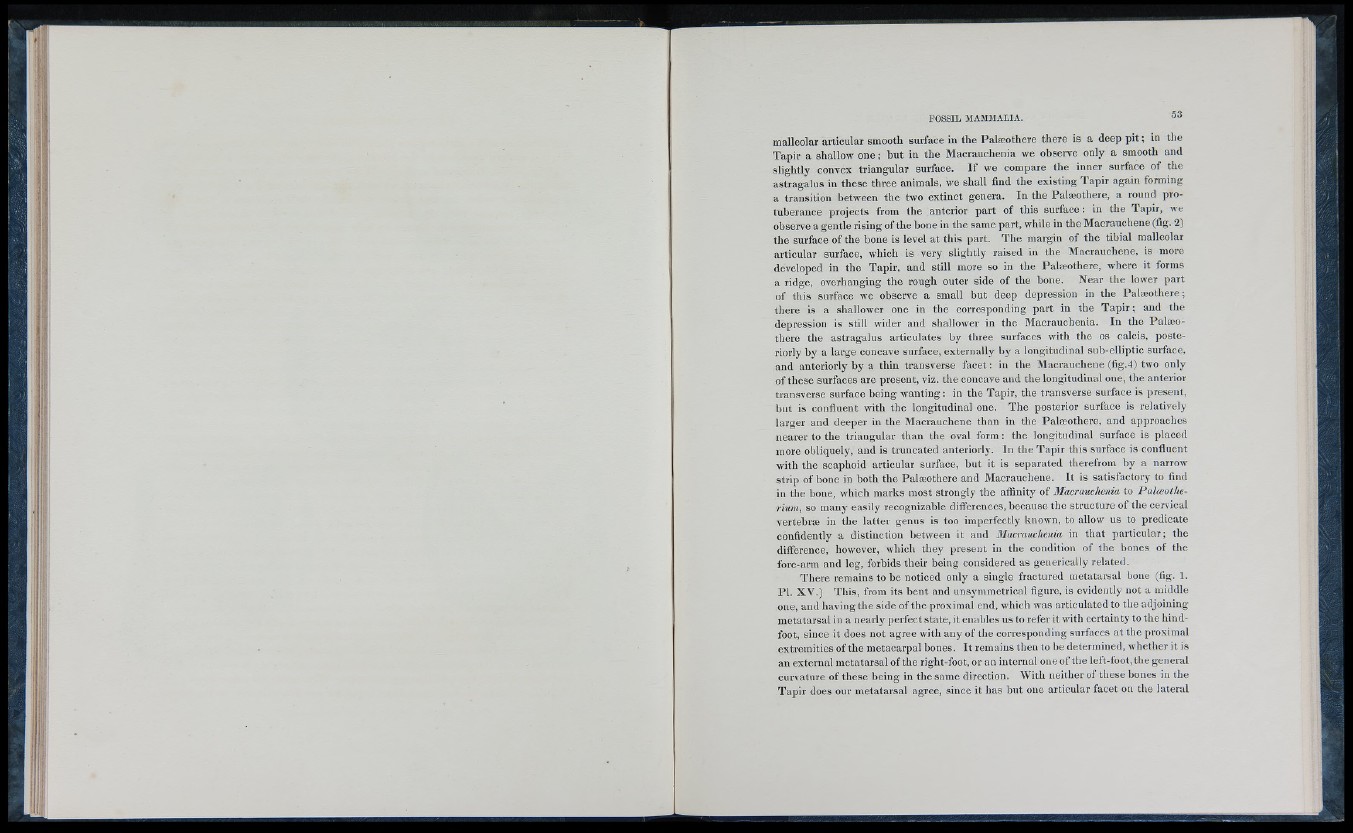
i il '■f
't teN
malleolar articular smooth surface in the Palæothere there is a deep pit ; in the
Tapir a shallow one ; but in the Macrauchenia we observe only a smooth and
slightly convex triangular surface. I f we compare the inner surface o f the
astragalus in these three animals, we shall find the ex isting Tapir again forming
a transition between the two ex tinc t genera. In the Palæothere, a round protuberance
projects from the anterior part of this surface : in the Tapir, we
observe a gentle rising o f the bone in the same part, while in the M acrauchene (fig. 2)
the surface o f the bone is level at this part. The margin o f the tibial malleolar
articular surface, which is very sligh tly raised in the Macrauchene, is more
developed in the Tapir, and still more so in the Palæothere, where it forms
a ridge, overhanging the rough outer side o f the bone. Near the lower part
o f this surface we observe a small but deep depression in the Palæothere ;
there is a shallower one in the corresponding part in the T ap ir ; and the
depression is still wider and shallower in the Macrauchenia. In the P a læ o there
the astragalus articulates by three surfaces with the os calcis, posteriorly
by a large concave surface, externally by a longitudinal sub-elliptic surface,
and anteriorly by a thin transverse facet : in the Macrauchene (fig.4) two only
o f these surfaces are present, viz. the concave and the longitudinal one, the anterior
transverse surface being wanting : in the Tapir, the transverse surface is present,
but is confluent with the longitudinal one. The posterior surface is relatively
larger and deeper in the Macrauchene than in the Palæothere, and approaches
nearer to the triangular than the oval form : the longitudinal surface is placed
more obliquely, and is truncated anteriorly. In the Tapir this surface is confluent
with the scaphoid articular surface, but it is separated therefrom by a narrow
strip o f bone in both the Palæothere and Macrauchene. It is satisfactory to find
in the bone, which marks most strongly the aiflnity o f Macrauchenia to Palceothe-
rium, so many easily recognizable differences, because the structure o f the cervical
vertebræ in the latter genus is too imperfectly known, to allow us to predicate
confidently a distinction between it and Macrauchenia in that particular; the
difference, however, which they present in the condition o f the bones o f the
fore-arm and leg, forbids their being considered as generically related.
There remains to be noticed only a sing le fractured metatarsal bone (fig. 1.
PI. X V .) This, from its bent and unsymmetrical figure, is evidently not a middle
one, and having the side o f the proximal end, which was articulated to the adjoining
metatarsal in a nearly perfect state, it enables us to refer it with certainty to the hind-
foot, since it does not agree with any o f the corresponding surfaces at the proximal
extremities o f the metacarpal bones. It remains then to be determined, whether it is
an external metatarsal o f the right-foot, or an internal one o f the left-foot, the general
curvature o f these being in the same direction. With neither of th e se bones in the
Tapir does our metatarsal agree, since it has but one articular facet on tlie lateral